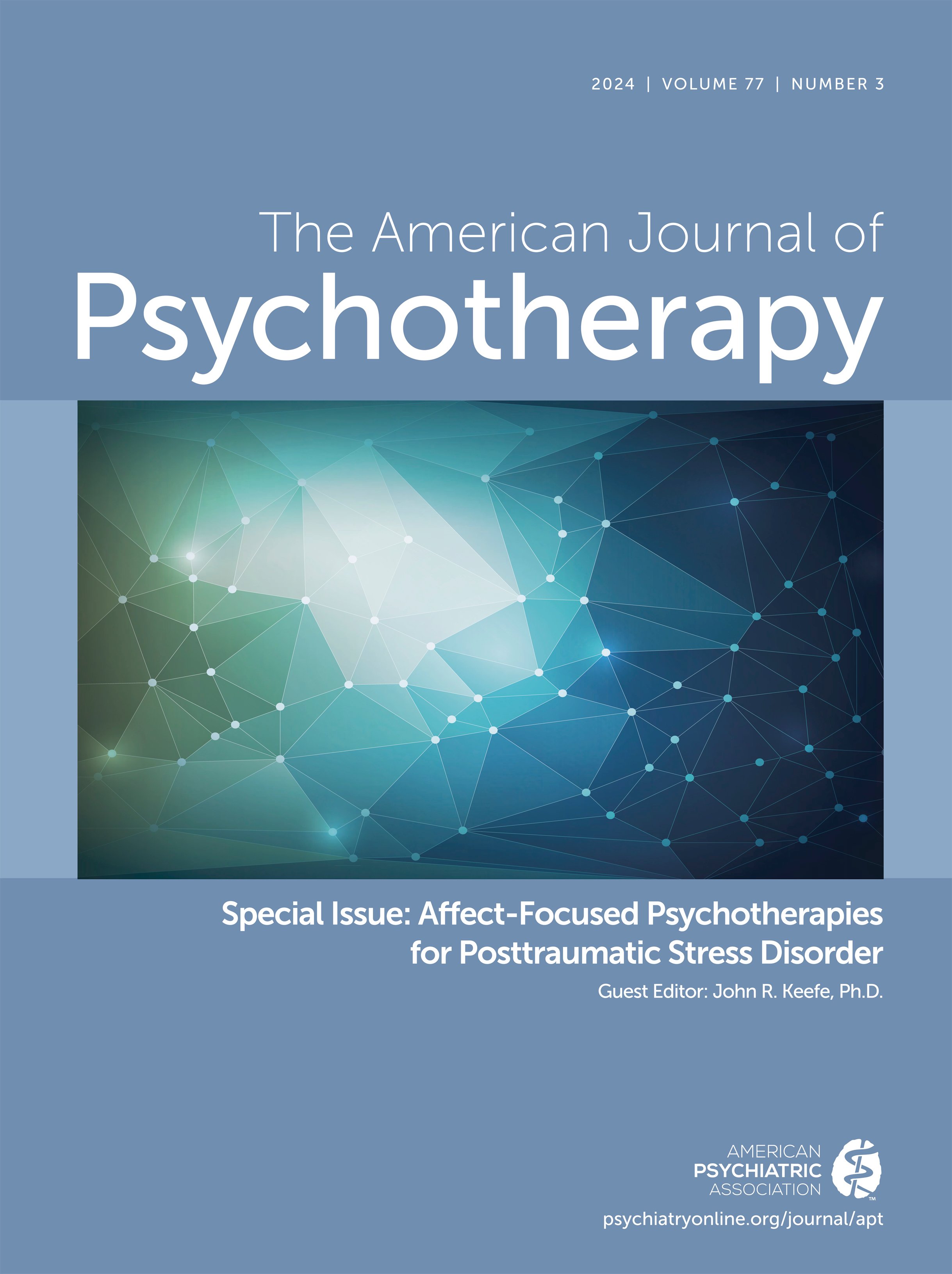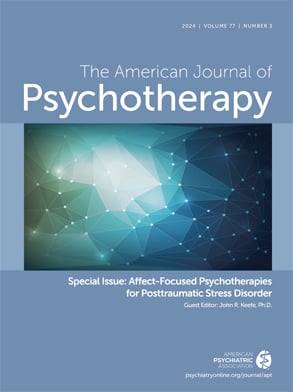Mainstay trauma-focused cognitive-behavioral therapies (CBTs) for posttraumatic stress disorder (PTSD), such as prolonged exposure and cognitive processing therapy, are effective, but dropout rates can be high (e.g., 45%–55% in the largest PTSD trial conducted to date, in the U.S. Department of Veterans Affairs system [
1]) and clinical response rates are suboptimal (35%–50%) (
2). Although some avenues for improving PTSD treatment outcomes have been explored, including expanding access to effective treatments (e.g., telemedicine) and enhancing the practice of these treatments (e.g., adherence to and competence in treatment techniques), a less researched path is investigating treatments that employ meaningfully different interventions that target disparate psychopathological processes in PTSD (
3). Trauma-focused CBTs are conceptualized as working through exposure to traumatic memory cues and modifying consciously accessible beliefs generated or aggravated by traumatic events (
4), but other therapies, such as interpersonal psychotherapy (IPT) and psychodynamic therapies (PDTs), may better target different features of PTSD that are more salient or clinically relevant for some patients.
This special issue, for which I served as guest editor, highlights treatments for PTSD that have been developed outside trauma-focused CBT and that target affective and interpersonal mechanisms of change in PTSD, that is, mentalization—especially regarding trauma-related meanings—and attachment. Mentalization is the capacity to reflect on one’s own intentional mental states (e.g., feelings, wishes, and motivations) and those of others (
5). Patients with PTSD are often affectively numb (
6) and exhibit impairments in mentalization (
7–
9), particularly with regard to mental states linked to traumatic events (
9,
10). In affect-focused psychotherapies, deficits in mentalization are conceptualized as driving difficulties in proactively addressing issues and conflicts related to trauma’s impacts. Mentalization also aids in distinguishing contemporaneously relevant signals of safety versus those of threat—which may pertain not only to PTSD-related experiences of anxiously avoiding individuals who are benign but also to difficulties with retraumatization, wherein patients can be unconcerned with risky situations that evoke past traumas.
Relatedly, patients with PTSD often exhibit dysregulated attachment that is aggravated by trauma exposure (
11,
12), rendering interpersonal relationships fraught and more difficult to use for social support. Patients with childhood trauma or with complex PTSD as defined by
ICD-11 (involving disturbances to self-organization) often demonstrate profound disruptions in attachment, engaging in disorganized or contradictory approach and avoidance attachment strategies or being flooded with traumatic intrusions on activation of the attachment system (
13,
14). Premorbid attachment dysregulation may also represent a strong risk factor for developing PTSD in the wake of a traumatic event (
15,
16).
Affect-focused treatments for PTSD and anxiety disorders, described by Markowitz and Milrod (
17) in this issue and including therapies such as IPT (
18) and PDT (
19), putatively work via mentalization and attachment mechanisms (
11,
20,
21). Markowitz and Milrod (
17) highlight the key similarities of IPT and PDT as compared with trauma-focused CBTs, such as a focus on the identification and expression of dissociated or difficult-to-express affects, the technique of working through how trauma affects interpersonal relationships, and the use of a more flexible, exploratory treatment structure. Using this framework, Keefe and colleagues (
22) examine randomized controlled trials (RCTs) of IPT and PDT, drawn from a larger, ongoing meta-analysis, to quantitatively summarize the current state of the literature on these affect-focused treatments. Encouragingly, IPT in particular has demonstrated effects comparable to those of prolonged exposure in two separate, high-quality RCTs and to those of selective serotonin reuptake inhibitor monotherapy in another RCT.
Further developing the unique interventions characteristic of affect-focused treatments, Chen and Nehrig (
23) posit dream work in PDT for PTSD as facilitating reflection and providing an opportunity to work with and potentially revivify feelings, fantasies, and conceptions of self and others that may have been ossified or lost in the adaptation to trauma. They provide several fictionalized case examples of trauma-focused psychodynamic psychotherapy (TFPP; a manualized PDT for PTSD [
19]) adapted from material from an ongoing clinical trial that prominently featured exploration of dreams in the therapy process. Of note, a therapeutic focus on dreams and fantasies has been found in psychodynamic process-outcome work to be uniquely and positively associated with improvements in anxiety symptoms relative to general psychodynamic treatment (
24).
Affect-focused therapies for PTSD also place greater emphasis on the use of the therapeutic relationship as an arena to experientially understand and work on often intense interpersonal patterns that are infused with meanings from traumatic experiences. Kehn and colleagues (
25) report on a case of TFPP with a veteran, originally from the Caribbean, who staunchly requested to work with a therapist of color but instead had to navigate working with a White therapist. Kehn et al. outline how she and her patient worked together to understand how her patient’s PTSD emerged in part through disruptions in trust in intimate relationships, such as their therapy relationship. Trust issues also intersected with racialized experiences in which the patient felt safe in neither White nor Black American spaces. Kehn and her patient’s attention to this overlap between traumatic experiences and experiences of systemic oppression (
26) was cited by her patient as critical to treatment, and the patient gradually became more open to the idea of being cared for as a viable, rather than disavowed, prospect in her life. Swee and colleagues (
27) make the case for the use of compassion-focused therapy, a transdiagnostic treatment for problems with shame and self-criticism, among individuals with complex PTSD who also exhibit disturbed self-organization symptoms such as negative self-concept. They emphasize how relational trauma (especially trauma caused by caregivers) promotes negative expectations of receipt or self-deservedness of care, leading individuals to engage in self-criticism and self-shame rather than self-soothing on activation of the attachment system. Compassion-focused treatment aims to disrupt self-critical processes through modeling and activating flows of self-compassion by, for example, attending to fears of compassion and painful emotional experiences as they emerge in the therapeutic relationship and using experiential interventions to personify and understand the patient’s self-critic.
Kay and colleagues (
28) explore the role of childhood trauma in the clinical case complexity of patients with panic disorder and in the moderation of the antipanic effects of three panic-focused psychotherapies—CBT, panic-focused PDT, and applied relaxation training—with data from a two-site RCT. Kay’s findings indicate diminished effects of relaxation-focused therapies, which do not address traumatic meanings, among individuals with extensive trauma histories. Finally, Robinson and colleagues (
29) summarize the trauma-based model of dissociative identity disorder (e.g., generating dissociated, “not-me” self-states to cope with ongoing intense relational trauma) and its integrative treatment within an affect-focused therapeutic frame and describe their work with a Lived Experience Advisory Panel of patients with dissociative identity disorder. They outline the panel’s aim to combat stigma and misunderstanding surrounding dissociative disorders and to leverage the lived experiences of affected individuals to guide clinical and research needs.
Interpersonal and affect-focused psychotherapies for PTSD reflect a category of mechanistically similar treatments for PTSD, akin to the similarities among trauma-focused CBTs, and may serve treatment needs less addressed by mainstay therapies, thereby helping a unique subset of patients with PTSD. Additional RCTs of affect-focused approaches are needed to better understand the efficacy of such approaches (e.g., in the case of PDT) and to identify which patients would benefit the most from affect-focused approaches. Just as diminishing conditioning to trauma cues can be helpful for patients with PTSD, regaining or developing the capacity to reflect on meaning in one’s life—feelings that may have been forbidden or dangerous in traumatic situations (e.g., anger), what one desires or needs, and how one wants to be treated by others—can be powerfully therapeutic. Patients will benefit from a broader availability of differing evidence-based therapeutic approaches to PTSD—no single therapeutic approach to PTSD can help all patients, and affect-focused psychotherapies offer a unique therapeutic lens that may help address current gaps in treatment efficacy.

